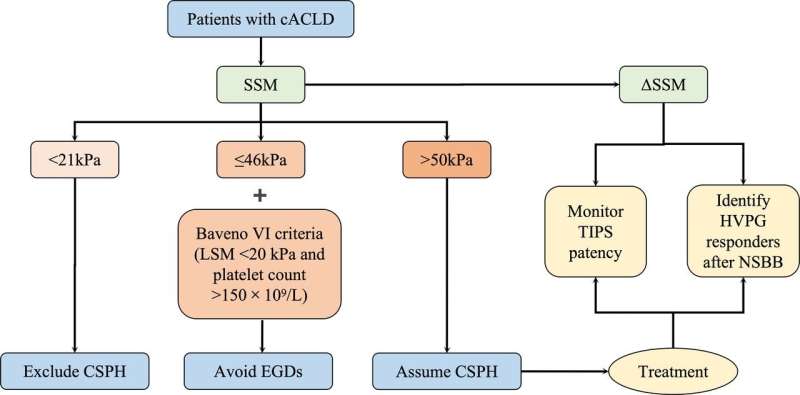This article has been reviewed according to Science X's editorial process and policies. Editors have highlighted the following attributes while ensuring the content's credibility:
fact-checked
proofread
New test shows promise for diagnosing and managing portal hypertension

Portal hypertension (PHT) is a severe complication of chronic liver disease, like cirrhosis, where increased pressure builds up in the portal vein. This major blood vessel drains blood from the intestines, spleen, and stomach to the liver. This can lead to life-threatening complications such as internal bleeding and liver failure.
Currently, the most accurate way to diagnose PHT is an invasive procedure that measures pressure directly in the liver. However, this procedure is uncomfortable for patients and carries a small risk of complications.
Researchers are excited about a new, noninvasive technique called spleen stiffness measurement (SSM), which uses sound waves to assess the stiffness of the spleen. The spleen is an organ located near the stomach that filters blood and fights infection. When PHT is present, the spleen becomes enlarged and stiffer. SSM uses a painless technique similar to an ultrasound to measure these changes in stiffness.
Several studies have shown that SSM is highly accurate in detecting PHT. SSM may be more accurate in some cases than existing methods, such as measuring liver stiffness with ultrasound. This could be because the spleen is more directly affected by changes in portal pressure than the liver.
The benefits of a non-invasive test like SSM are numerous. First, it would eliminate the need for invasive procedures in many patients, making diagnosis safer and more comfortable.
Second, SSM could be used to screen patients with chronic liver disease for PHT at an earlier stage, allowing for earlier intervention and potentially preventing complications.
Third, SSM could be a valuable tool for monitoring how well treatments for PHT are working. By tracking changes in spleen stiffness over time, doctors could determine if a patient's PHT improves or worsens in response to medication or procedures like a transjugular intrahepatic portosystemic shunt (TIPS).
While SSM is promising, further research is needed to confirm its effectiveness in different patient populations and optimize its use in clinical practice. For example, researchers are still determining the best cut-off values for spleen stiffness to diagnose PHT definitively.
Overall, SSM is a promising new tool that could revolutionize the diagnosis and management of portal hypertension. This non-invasive technique can potentially improve patient care, reduce health care costs, and ultimately save lives.
The work is published in the journal eGastroenterology.
More information: Xiaoming Xu et al, Spleen stiffness measurement as a non-invasive assessment in patients with portal hypertension, eGastroenterology (2024). DOI: 10.1136/egastro-2023-100031



















